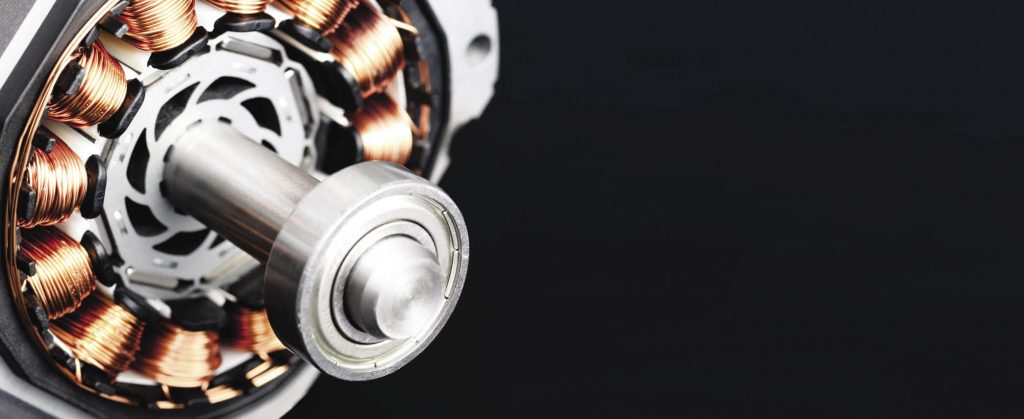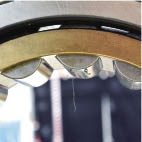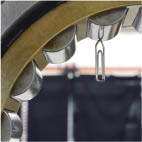

Photo credit: Bosca78 / Getty Images
The question about allowable magnetism in bearings arose from a shaft being magnetized when a manufacturing company cut a portion of its shaft that the bearing was to be mounted on. Since the bearing was to be mounted onto this magnetized shaft, it was felt that the shaft would make the bearing magnetized as well. This would be like that experiment a child does with a magnet and paper clips, to see how long of a chain of paper clips could be made from the magnet.
What is wrong with a bearing being magnetic?
Iron is one of the most abundant elements on earth, and iron oxide makes an excellent grinding media. If you have a precision piece of machinery that’s magnetic that attracts iron/iron oxides, you generate a situation in which a bearing pulls this grinding media to it, and it can grind itself away. Also, as the bearing wears away, the resultant product is itself a grinding media multiplying the problem. Having a bearing that attracts a grinding medium is not a good thing.

Photo credit: Maurer Magnetic AG.
There is not much material published on this topic; however, there is a paper published by the Electrical Apparatus Service Association (EASA) — “Demagnetizing Motor Shafts to Prevent Bearing Failures” by Cyndi Nyberg — from the October 2005 issue of Currents. It suggests that a measurement of no more than two gauss should be measured in the bearing area of the shaft.
For a typical maintenance shop (as opposed to an electric motor shop), such an instrument to measure gauss is not common. However, there is a clear recognition that whatever manufacturing processes there are for a shaft that a bearing will be mounted on, there must be some way of both measuring and eliminating magnetism that may be created by that process.

Photo credit : Maurer Magnetic AG.
Another cause of magnetism is an induction heater, a common tool in shops that install bearings. It creates an electric field that heats the bearing (like a microwave oven), but it also causes magnetism in the bearing. More sophisticated induction heaters have an automatic demagnetization cycle (demag cycle); however, with less-expensive systems, the bearing must be “waved through the uprights” while the induction heater is on, to ensure appropriate demagnetization occurs. This is concerning, as this depends on the passing on of knowledge, as this type of induction heater lacks the specific instructions to alert the user to this key step in the bearing heating process.
For induction heaters with demag cycles, the stated “norm” is that the magnetism must be below two ampere/centimetre (a/cm) (of interest, one a/cm, is about 0.000126 tesla and one tesla is 10,000 gauss). These higher-grade induction heaters ensure that they do not leave the bearing with magnetism, and thus unintentionally shorten its life.
Another common case of magnetism in a bearing is when a bearing failure occurs. The bearing has to be removed from the shaft or housing, and it is cut with a zip cutter or other grinding/cutting device. This cutting action will impart magnetism to the bearing rings.
Later, when the bearing is being inspected by a technician, they may notice that this bearing is magnetic. Is this what caused the failure? No, just as in the first case, the cutting of a ferrous metal can induce magnetism. The bearing as inspected is magnetized, but this was caused by the removal process.
Bearing companies do understand the processes by which magnetism can be induced, and they apply the appropriate technology to correct this issue. A company in Switzerland supplies equipment to bearing manufacturers to appropriately demagnetize bearings and components in the manufacturing process.
One of the processes in the manufacturing of bearings that is identified as a cause of magnetization is the hot riveting of a brass cage in a cylindrical roller bearing. This process causes the assembled bearing to become magnetic. As a standard practice, this is corrected by the appropriate tools in the manufacturing process.
Having a bearing that has become magnetic can be detrimental to its operation. The sources of magnetism in the bearing manufacturing process are well understood and closely controlled. Therefore, the likelihood of a new bearing being magnetic from the package is highly unlikely. However, further handling of the bearing, such as using an induction heater without a demag cycle, or having the shaft itself become magnetic from its manufacturing process, can induce detrimental magnetism in the bearing.
Is there such a thing as a “magnetic bearing”?
Yes, there is. “Magnetic bearings” are used in applications such as high-speed compressors for natural gas facilities and for compressors for chillers in large urban buildings. The shaft is supported by an electromagnetic field, which allows for oil-free operation and speeds of up to 40,000 rpm. Due to the complexity of these bearings, which levitate the shaft, these bearings are expensive and are not very common. MRO
